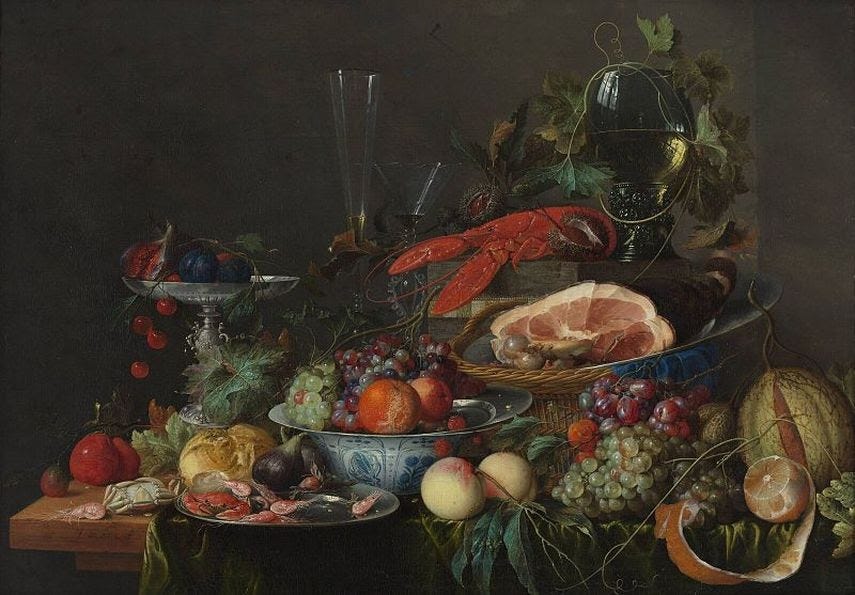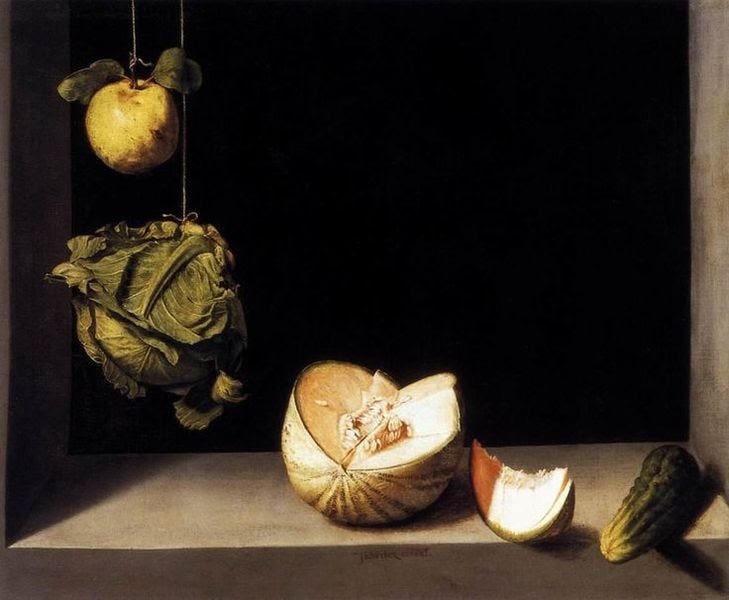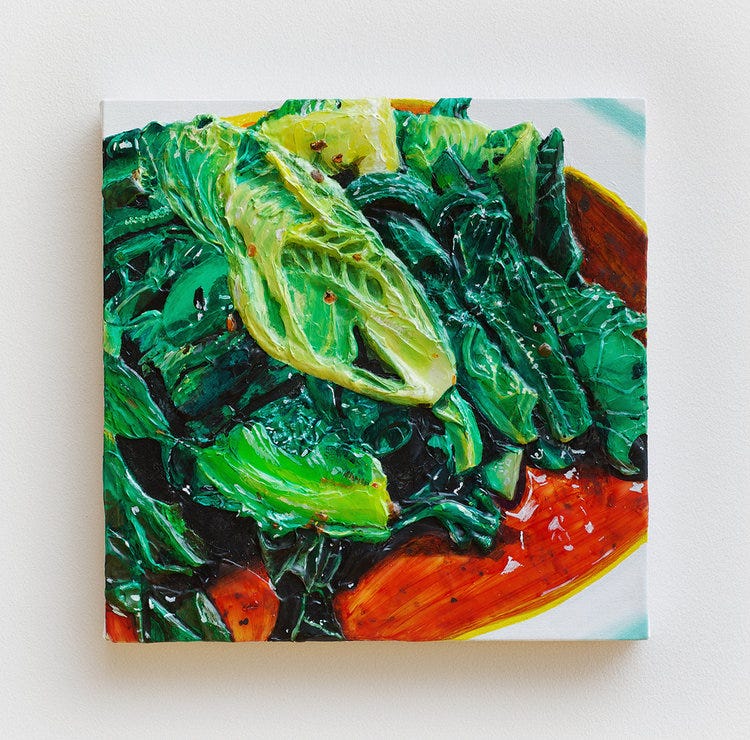Food in/as Art
A newsletter issue which explores all the ways in which food can be art, how this relates to our experience of food and eating, and how we may use this towards our own ends.
In this newsletter we will be looking at the classic to contemporary ways that food has been art, from still life to sculpture; tips for how to make everyday meals artistic endeavours; food photography and the songs about food that bring us joy; we’ll signpost some artists and instagrammers to follow to make your feed a home for food art; and, finally, we’ll discuss our upcoming still life painting event and our next newsletter!
Still Life
Classic still lifes and their portrayal of food, while displaying extreme wealth and extravagance, do little to elevate the food we eat and experience daily to be considered art, because they often feature foods far beyond most people’s everyday remit. Perhaps the point of still life is that it shows food in contexts removed from the everyday, with foodstuffs and compositions we wouldn’t see in our daily lives.
This example of a Dutch Baroque still life shows the abundance and wealth that is often displayed in classic examples of still life. While it demonstrates that food can often be symbolic, it does little to change the way we view food.

Jan Davidsz de Heem - Still life with ham, lobster and fruit, circa 1653.
I’ve included this still life from Juan Sanchez Cortan simply because I like it! There’s something whimsical about the suspended fruit, and really proves that still life doesn’t aim to recreate a practical meal spread. Here the stark black background characterises a classic element of still life - come to our still life workshop on Tuesday 20th to create your own!

Juan Sanchez Cortan - Still Life With Quince, Cabbage, Melon, and Cucumber, 1602-1603
Some contemporary artists have chosen to subvert the meanings of classic still life, particularly their inaccessibility, by including everyday foodstuffs in their work.
One such artist is Dave Pollat, who buys artwork secondhand and adds in his own elements.

I appreciate how Pollat draws a parallel in this painting between the wealth-obsessed consumerism of classic still life works and how this compares to the consumption of mass-culture products such as those from McDonalds. While McDonalds is far more accessible, and recognisable, than the food depicted in works such as de Heem’s, it still represents a culture focused on symbolic consumption; where the pinnacle of consumption was once expensive food, it is now food that is culturally recognised. Equally, maybe the painting is just amusing in its juxtaposition of fancy flowers and fast food - what do you think?
An interesting example of contemporary still life work is that of Gina Beaver. Her 3D canvases blur the lines between painted still life and food sculpture. There is something unapologetically chaotic and messy in her work. Contrary to still life work that attempts to glorify or elevate food, Beaver’s work revels in the messiness and texture of food. To see more of what I mean, go to her website here. The work below is from the series ‘Palate’.

Gina Beaver, Greens with Brown Sauce, 2012, Acrylic on Canvas
Content Warning - diet culture
Food is a beautiful thing - words, tips and recipe by Isabella Sumsion
In today’s diet culture, food has been turned into a thing of precision; controlled portions, exact calories, macros, micros, all wrapped up in uniform packaging. No wonder our relationships with food have become confused and disillusioned when the joy, fun, beauty, freedom and creativity that should be inherent to food have been taken away. Food is represented in art yes, but food itself is also art.
Think of the TV programme Masterchef, and the plates of food that look completely beautiful. Vibrant colors, textures and compositions on a plate rather than on a canvas. But beautiful creative food shouldn’t be restricted to a TV screen, an Instagram post, or a fancy restaurant. Cultivating a positive relationship with food can start with tuning into your inner food artist. I am not talking about expensive garnishes and fancy foams, simply enjoying the colors and textures and shapes in food.
We probably put effort into making food look appealing for other people, but it might not be something we think to do for ourselves. But meals for one are just as important as meals for many, and we deserve to take a few minutes to have fun putting our food on the plate, giving us more time to enjoy and connect with food in a positive way. This doesn’t mean that every meal should look like it’s from a five-star restaurant, or that you shouldn’t sometimes eat pasta straight from the saucepan to save on washing up - like with everything in life it is always best to have a balance.
But sometimes make a conscious effort to treat yourself, by allowing time to get artsy with your dinner, and look at your food as a beautiful thing. Now we are all glued to our laptop screens, one of the easiest things you can do to give your eyes a break is take proper breaks for food, away from the screen, and spend those few extra minutes having a bit of fun putting a plate together (feel free to play dramatic master chef music in the background)! A few minutes of enjoying the way your food looks - it doesn’t matter if that means arranging chips on a plate in a smiley face or feeling sophisticated and throwing some rocket on top of something - is really beneficial for cultivating a more positive relationship with food.
Here are some cheap and easy tips to get started on your food artist’s journey…
Find a bowl and a plate that you love
I am not talking about going out and buying an expensive stylish dining set! But having something to serve yourself food in that brings you joy is going to add to your relationship with food. A bowl that you like the shape of, a plate with a funky pattern, a mug with a nostalgic cartoon character on it, whatever it is that makes you happy. Charity shops are great places to pick up mismatching colorful bits and pieces for your kitchen cupboard.
Use ingredients with some funky colors!
Whether it’s beetroot for a punch of pink or some green coriander, adding something colorful is a great way to jazz things up
All about the sprinkles! A sprinkle of chili flakes, herbs, even just black pepper, it doesn’t need to cost more than a few pennies. It might not be a necessity to the food, but food isn’t just about necessity, it’s about joy too!
A recipe to prove that it really is simple – TOMATOES ON TOAST
Step 1 – toast some bread (white, brown, sourdough, whatever you love)
Step 2 – in a bowl mix the juice of a lemon, salt and pepper, 1 tbsp tahini, 1 tbsp olive oil, 1 handful of olives (if you like olives, if you don’t then definitely not!), 2 minced garlic cloves, 3 handfuls of cherry tomatoes cut in half and some chopped fresh or dried basil
Step 3 – Grate some of the lemon zest over the top for a splash of yellow and sprinkle over a pinch of chilli flakes
Step 4 – enjoy your masterpiece
Food as a medium
The most obvious way in which artists can draw our attention to how food can be art is by constructing artworks that meet the standards of high art through food mediums. Below are a few artists who use food as a medium.
Content warning: mention of slavery
In 2014, Kara Walker displayed ‘A Subtlety, or the Marvelous Sugar Baby’ in a disused sugar factory. The installation was a sugar-coated sculpture of a woman, prompting discourse around how the sugar trade, and sugar becoming more widely available, was reliant on the slave trade. This artwork demonstrates that food production is intertwined with injustice: just because we need and rely on food, we should not take it for granted that it is always ethical. Read a more in depth analysis of the work here.

Rirkrit Tiravanija is an artist who has explored the communality of food, and sharing of culture, by cooking for museum-goers in gallery spaces and allowing them to eat what he makes. This elevation of an everyday activity of cooking to something which can legitimately happen as art in a performative space characterises the idea of everyday processes such as cooking and eating being considered more deeply as art. This type of art also makes viewers active participants and may be impactful for the individual in terms of illuminating their relationship with food.
Gayle Chong Kwan, a London-based artist, made elaborate sculptures from food, including herbs and spices, in order to engage multiple senses with one artwork. Click here to hear her talk about her process and thinking behind the exhibition.

Carl Warner’s landscapes constructed from food are cute - which is probably why he has been commissioned to work with a range of companies. But beyond the fact that broccoli does look like trees, how can his work inform our perspective on food? For me, his work highlights that for every texture and shape, there is a food that can mimic it - the range of foodstuffs available to us is baffling!

Amelia Fais Harnas painted with red wine for ten years before retiring the medium. Check out her website to see her full range of works. While wine is a pretty palatable food medium compared to some more subversive choices, I think some of her paintings are really ethereal and so are worth mentioning!

Photography
Food photography is something strongly linked with commerciality - think M&S style images of fancy food or too-good-to-be-true McDonald’s burgers - but it may also serve to draw our attention to the beauty of food or subvert our food expectations. Of course, now meal pictures on Instagram mean we can all be food photographers!
In a series called Figures and Wares, Bill Durgin photographed models posed as/with food. Durgin’s work typically challenges our expectations of how we see bodies (see his other work here) in that he photographs models posed in bent in positions that obscure the way we typically see bodies posed. The addition of food and elaborate garments to these poses means we are left with photographs that draw a parallel between food and bodies. Perhaps Durgin is suggesting that as dressed up as we can be, we are never far from the natural and the organic. The implications of this for our relationships with food are that we should both embrace our part of the natural world and our connection with the food we eat, and embrace food as objects of opulence and beauty.

Beth Galton is a food photographer who has worked with many high-profile brands. While some of her photos are classic food photography, others have something a little funny about them, and some just look properly tasty. I recommend having a browse about her website to gain a fresh appreciation of the beauty of food.

Maciek Jasik’s series ‘Secret Lives’ aims to recapture the mystical and mysterious elements of food that he feels have been lost in a world in which we are disconnected from the food we eat. He says, ‘The modern world has separated us from the origins and uses of fruits and vegetables; we know them only for the flavors and textures they provide. Until only very recently, each held its own mystique, mythology, symbolism and connection to the culture and afterlife.’ To remedy this, he has photographed food in an unusual way…

What do you think about these photographs? Do they recapture the mystical element of food - or are they just… mist-ical! The colours are beautiful, but I can’t help but think that the brightly coloured fog and backgrounds take away from the aesthetics of the food itself?
Music
For music that celebrates food, check out our new GUFAB Food Joy playlist - now on spotify! Featuring songs that feature food (at least explicitly - I won’t speak on the metaphorical meanings…) and make us feel happy/sexy/silly, have a skip through and see if any songs speak to you! If you have any songs that spark food joy, feel free to pop us an email or message us on Facebook or Instagram with any playlist suggestions!
Artists to follow
It’s super easy to support contemporary artists (without having to spend lots on art) by fuelling the algorithm and following them on Instagram! I also find it nice to saturate my Instagram feed with creative accounts to add a little something different to the performative posts and very tempting adverts...
Dave Pollat, as featured above in the still life section, makes additions to thrift store paintings, see the work he features on Instagram here.
I will plug Eliza Hopewell (@elizahopewell) wherever I can, even if her work is not strictly food related! She paints ceramics depicting the female form - so perhaps a Hopewell-inspired plate could be the thing to elevate your meal experience to that of an artistic pursuit!
Social Media Accounts to Follow
Here are some Instagram accounts featuring beautiful and inspiring food:
Nigel Slater (@nigelslater)
Slater’s account features some very aesthetically pleasing meals and focuses on the natural side of food- the growth and nourishment of ingredients in the garden. His photos appreciate the beauty of ingredients in our food and the process it takes to turn them into a meal.
Lucy Parker (@lucy_and_lentils)
Parker presents her culinary creations as colourful, artistic and inviting. This account is great inspiration for all kinds of recipes, many of which are easy to make.
Chika (@shewhoeats)
This food photography account is another great source of appreciating the beauty in food. With lovely calming colours, Chika enhances simple foods in gorgeous photographs.
Upcoming Events
If you’re interested in food as art, come along to our still life workshop for an all-levels-accessible art workshop inspired by all things discussed in this newsletter. It’s on Tuesday 20th October from 5:30-6:30pm. Check out the Facebook event for all the information, and feel free to message us any questions!
This newsletter was written and edited by Thalia Groucott, with contributions from Isabella Sumsion and Ruth Johns-Bishop. Our next newsletter is all about Halloween and Food and Bodies, so if you’re interested in writing something, please get in touch at gufabpositivitysoc@gmail.com!



